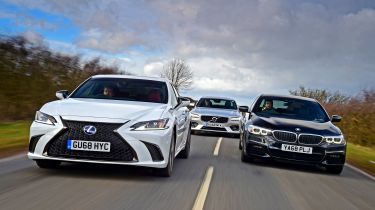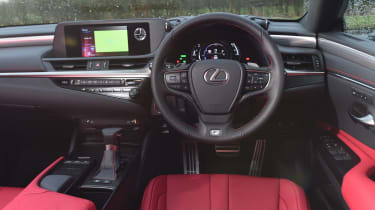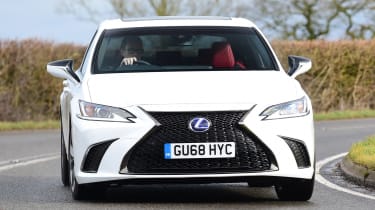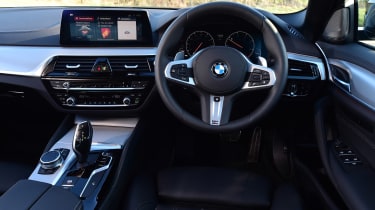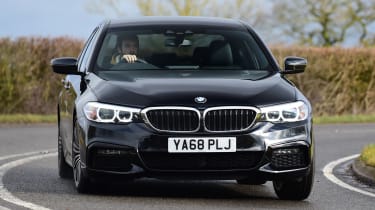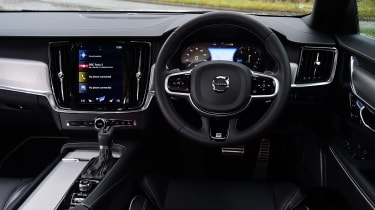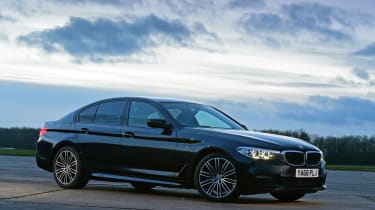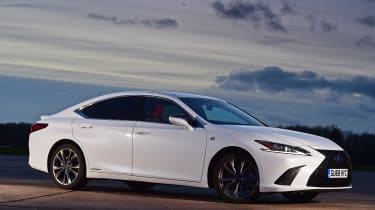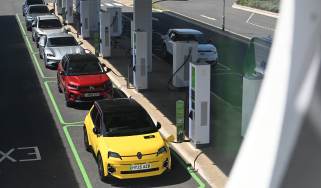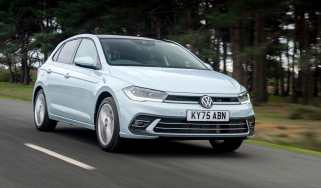Lexus ES vs BMW 5 Series vs Volvo S90
Can the new hybrid Lexus ES make an impression on exec saloon big-hitters such as the BMW 5 Series and Volvo S90?
Lexus’s ES nameplate isn’t a familiar sight in the UK. In fact, this is the first time the model has officially been sold in Europe, even though this new car is the seventh generation of the ES. It replaces the GS, so this is the Japanese firm’s new executive saloon class challenger – and in typical Lexus fashion, it’s a hybrid.
Compared with big players Audi, BMW and Mercedes, Lexus is a relative minnow when it comes to sales in this sector, but there’s proof that an outsider can achieve success here.
Just look at Volvo with its S90 saloon. The Swedish model is here because it blends stylish design with space, performance with technology and practicality with driving dynamics. So the Volvo proves it can be done, and this is what the Lexus has to live up to. If the ES can follow in the S90’s footsteps, it will be a successful machine.
However, the one competitor the Japanese newcomer will have to overcome if it is to rise to the top of the ultra-competitive executive saloon sector is the BMW 5 Series.
It’s still our favourite car in this class, but the Lexus is sporting some technological innovations that could help the ES achieve its goal. Read on to find out how it fares.
Lexus ES
| Model: | Lexus ES 300h F Sport |
| Price: | £38,150 |
| Engine: | 2.5-litre 4cyl petrol/e-motor, 215bhp |
| 0-60mph: | 8.2 seconds |
| Test economy: | 45.0mpg/9.9mpl |
| CO2: | 106g/km |
| Annual road tax: | £130 |
The ES replaces the GS as the executive saloon offering in Lexus’s range. At £38,150 for the 300h F Sport, it’s cheaper than its rivals, but still gets plenty of kit. Is it a better proposition as a result?
Design & engineering
Under the skin, the ES uses plenty of elements from the Global Architecture set-up that’s achieved plenty of success with many of Toyota and Lexus’s new generation of cars. It’s based on the brand’s GA-K platform.
Used - available now
The 300h powertrain is the only option in the range and combines a 2.5-litre four-cylinder naturally aspirated petrol engine with an electric motor to boost the output. There’s a total of 215bhp, which is 28bhp more than the 520d and S90 D4.
However, the Lexus also has to carry around a relatively old-school Nickel-metal hydride battery, which isn’t as sophisticated as the more modern lithium-ion battery chemistry in the latest crop of plug-in hybrids. Still, this tech should provide a boost in performance, while helping keep CO2 emissions relatively low for a big saloon car.
That means it should be cheap to run, especially because it’s also a more cost-effective company car than its rivals. Yet inside it feels it. Material quality is okay in parts, but not so great in others. The plastic around the infotainment and the window switches on the doors, in particular, looks and feels cheap.
You do get a good level of equipment for your money, though, with satellite navigation, heated electric leather sports seats, parking sensors and a reversing camera, plus climate and cruise control. There’s lots of safety kit as standard, but the ES lacks the latest connectivity.
Driving
It’s clear that Lexus’s hybrid powertrains are improving with every successive generation, and the ES 300h proves as much. Development has improved the connection between the car and the driver, with the CVT automatic transmission feeling more direct. It’s still not the perfect option, yet it does at least mean the powertrain is now more responsive, while there’s an acceptable level of performance as well.
With no gears – only simulated ratio steps – we couldn’t record in-gear times during the test, but the ES 300h sprinted from 0-60mph in a respectable 8.2 seconds, while it took 7.3 seconds to accelerate from 30 to 70mph on full throttle; this latter test was only 0.1 seconds slower than the Volvo’s result.
However, the boost from the electric motor isn’t the strongest and it’s difficult to keep the ES going on electric power alone. It does give a small chunk of assistance in the background to fill in for the petrol engine’s deficiencies when it comes to performance.
You can take manual control of the gearbox, but with no actual gears there’s not much point. Instead, keep your enthusiasm in check and the engine is refined, pulling without needing to use lots of revs. Use maximum throttle and it’s more audible, but not much noisier than a diesel rival. It’s just the CVT holds the revs high constantly, so it’s more intrusive.
The Lexus’s ride and handling are less impressive, though. It struggles for traction, which isn’t helped by its front-wheel-drive layout, while the steering is not as accurate as the BMW or Volvo’s and the body control isn’t as taut, so the car loses its composure sooner than either test competitor.
Over rough surfaces the Japanese saloon also fidgets more aggressively, with constant high- frequency movements transferred through the suspension into the cabin. This means it jiggles around, where the 5 Series, in particular, is much smoother and more serene. Absorption of big bumps is also more limited than in its European rivals, but at least at high speed the engine is quiet.
Practicality
Accommodating a big battery pack in the chassis means cabin space or boot capacity is going to inevitably be slightly compromised, and it’s in the luggage bay where the ES suffers. With only 454 litres available, it’s some way down on its competitors’.
Open the rear door, slide inside and you’ll find that there’s plenty of legroom, although headroom is tighter and seems disproportionate to the amount of space to the seat in front.
The front of the cabin feels more cramped, though. There’s a big ‘transmission tunnel’ and while you get a satisfactory level of storage, it’s not as obvious or as easily accessible as in either the S90 or 5 Series.
Ownership
Lexus traditionally scores well in our Driver Power satisfaction surveys, and the brand’s 2018 result was no different. It took top spot in both the manufacturer and dealer polls.
Safety is equally strong, with the ES earning a full five-star Euro NCAP crash-test rating. That’s thanks to having 10 airbags, autonomous braking, lane-keep assist, adaptive cruise and auto high beam fitted as standard. Yet F Sport trim doesn’t get the option of blind spot monitoring and rear cross-traffic alert.
Running costs
Fuel economy is meant to be a hybrid strength, and the Lexus performed well here, equalling the Volvo’s 45.0mpg. A hybrid is also a benefit for business users, because the lower CO2 emissions – 106g/km in this case – put it in a more affordable Benefit-in-Kind tax band of 22 per cent, compared with 28 per cent and 29 per cent for the 119g/km BMW and 121g/km Volvo.
Company car drivers paying tax at the higher rate will only contribute £3,341 per year to run the ES. This is much cheaper than the £4,524 and £4,628 owners running the S90 and 5 Series respectively will pay.
Testers’ notes: “We were surprised at the few areas of questionable quality inside the ES, but the infotainment system is an even bigger frustration. This is all due to the touchpad interface.”
BMW 5 Series
| Model: | BMW 520d M Sport |
| Price: | £41,585 |
| Engine: | 2.0-litre 4cyl turbodiesel, 187bhp |
| 0-60mph: | 6.9 seconds |
| Test economy: | 42.8mpg/9.4mpl |
| CO2: | 119g/km |
| Annual road tax: | £450 |
The 520d is our favourite executive saloon, so the Lexus has nowhere to hide. This M Sport model is more expensive than the ES, at £41,585, but the 5 Series is such a talented car that it could just be worth spending the extra cash. Let’s find out.
Design & engineering
The 5 Series is such a famous nameplate and in its evolution into this seventh-generation model (this one is codenamed G30), the German car has risen to the top of its class.
It uses BMW’s CLAR (Cluster Architecture) platform, and offers a choice of rear and four-wheel-drive options. But we’re testing the two-wheel-drive 520d here. The same CLAR tech has been adapted for the new, smaller 3 Series, and a good deal of lightweight materials are used in the car to help keep the weight down to 1,530kg, so the BMW is 150kg lighter than the Lexus and 167kg less than the Volvo.
That weight advantage helps with agility, as does the 5 Series’ suspension layout. There are double wishbones at the front and a multi-link set-up at the rear. Our test model was also fitted with the £985 adaptive dampers that help improve the ride on our M Sport-trim car’s standard 18-inch alloys.
This 520d features a 2.0-litre four-cylinder turbodiesel engine that produces an identical 187bhp and 400Nm of torque to the Volvo, but the BMW is lighter, as we’ve seen, so full-throttle performance is superior to both its rivals’.
It’s wrapped up in a conservative-looking body compared with more modern BMW machinery, but this has been styled to help efficiency, too. There are Active Air Stream kidney grilles and air curtains behind the front wheels to help reduce drag and therefore boost fuel economy.
You can feel the engineering integrity inside and from the way it drives. Quality is strong and while the cabin design is a bit stark, it’s also functional and feels luxurious. That’s helped by the tally of standard kit.
All 5 Series models come with climate and cruise control, Bluetooth, DAB radio, LED headlights, front and rear parking sensors and heated leather seats. Also fitted as standard are a digital dash and BMW’s ConnectedDrive services, plus the Professional Navigation infotainment set-up, which is very good.
Driving
Having the lowest kerbweight of this trio helped the BMW achieve the best performance stats at our test track. The 0-60mph sprint took 6.9 seconds, which is fairly quick for a large diesel saloon, but it’s the in-gear tests that highlight the flexibility of the 520d.
From 30 to 50mph – simulating accelerating out of a town or village – the 5 Series easily had an advantage over the Volvo, and its figures between 50 and 70mph confirm that it will be the sharper car for overtakes and getting up to speed on the motorway.
And it’s on a high-speed road where the BMW is a consummate cruiser. It’s refined, the engine is hushed (it drones a little when it’s worked hard, but no more so than the S90’s motor) and the eight-speed automatic transmission is snappy and smooth. You almost never feel like it’s in the wrong gear for the situation. The car’s chassis balances performance, comfort and refinement similarly well. With the dampers in their softest setting, the BMW is smooth and controlled, absorbing cracks and crevices in the road with a relatively deft touch.
Body control is brilliant, which means the steering is the most direct of our test trio’s, even if it feels vague and offers little in the way of feedback. None of these cars is particularly communicative, though.
The BMW’s dynamism comes from its chassis. There’s agility here that the ES and S90 can’t match, plus subtle adjustability that means the 520d feels more engaging more of the time. Its trick is to deliver this without compromising in other areas.
Practicality
The BMW’s 530-litre boot is the largest on test, which also makes it more flexible than the Lexus’s, yet you don’t pay a price inside for passenger room. The rear is spacious and while there’s not as much legroom as in the ES, it’s more than sufficient. It’s also loftier, so taller passengers will be more comfortable.
In the front, the driving position is the best of our three contenders as well, while it’s also the most comfortable. However, the BMW does feel like a physically large car. The S90 offers better visibility.
Space inside for trinkets is a match for the Volvo, with a pair of cup-holders and a tray in front of the gearlever that doubles as the wireless smartphone charging area, which is a £475 option. The door bins are also large enough to hold big bottles.
Ownership
BMW finished in 21st place out of 26 in the makers’ chart of our Driver Power 2018 satisfaction survey, while Volvo was 13th. The German brand’s official franchises also trailed in the dealer poll, ranking 19th out of the 28 marques, with Volvo taking ninth position. Lexus achieved top spot in both categories.
The 5 Series doesn’t get quite as much safety kit as either rival. Autonomous braking is included, but blind spot warning, lane-keep assist and cross-traffic alert are all part of the £895 Driving Assistant pack.
Running costs
Both the Lexus and Volvo managed 45.0mpg, but because the former is petrol and the latter is diesel they’ll cost around £1,449 and £1,561 to fuel a year respectively.
The BMW returned 42.8mpg, which means an annual diesel bill over 12,000 miles of around £1,642 based on these figures. It’s worth it for the extra ability.
Testers’ notes: Options worth thinking about include a reversing camera (£375), power tailgate (£430) and Apple CarPlay (£235). However, we’d steer clear of extras such as the gimmicky gesture control, at £160.”
Volvo S90
| Model: | Volvo S90 D4 R-Design |
| Price: | £39,260 |
| Engine: | 2.0-litre 4cyl turbodiesel, 187bhp |
| 0-60mph: | 7.7 seconds |
| Test economy: | 45.0mpg/9.9mpl |
| CO2: | 121g/km |
| Annual road tax: | £140 |
Volvo’s S90 succeeded in joining a group of talented machines in the executive saloon class, holding its own on merit. That’s exactly what the new ES is aiming to do, so this £39,260 S90 in D4 R-Design trim is a brilliant benchmark for the Lexus. How does the Volvo stack up in comparison?
Design & engineering
The S90 uses much of the technology that has helped to establish Volvo as a premium player. The first car to do so was the XC90 SUV, which went on to take our 2015 Car of the Year crown, and the S90 packages those same winning ingredients in a smart exec saloon body.
Beneath the sharply-styled exterior is Volvo’s Scalable Product Architecture (SPA) platform, which was designed solely with four-cylinder engines (plus plug-in hybrids) in mind. Unsurprisingly, this D4 2.0-litre turbodiesel is the most popular engine option, and although its 187bhp is a little down on the ES’s output, it matches the BMW; and for torque as well, with 400Nm. As with the Lexus, power is sent to the front wheels through an eight-speed auto box.
The SPA platform employs double wishbones at the front, but a more unusual transverse leaf spring design at the rear, with an ‘integral link’ set-up.
As well as carving out its own engineering style with its latest round of cars, Volvo has created its own design signature, just like Lexus. This is obvious inside, where the S90’s cabin is detailed beautifully.
You get leather, good infotainment, decent safety tech and a great choice of trim combinations to give it a more individual feel, just like the ES. R-Design spec matches the F Sport Lexus and M Sport 5 Series and is competitively priced, at £39,260. On top of the above, it offers parking sensors, adaptive cruise, LED lights, climate control, a digital dashboard and nav, DAB radio and Bluetooth. There are also heated leather seats, keyless operation and a power tailgate, so it easily matches the Lexus and shades the BMW.
Driving
On standard 18-inch wheels the S90 rides sweetly, even with this R-Design model’s lowered sports chassis. It’s more comfortable than the Lexus, with smoother, plusher-feeling damping that allows the Volvo to move more in harmony with the road, rather than being jarred by it like the Lexus sometimes is.
On occasion it’s even more compliant than the 5 Series, but hit an aggressive, sharp bump and the S90 shudders more than the BMW does. The reaction is similar in the Lexus, while the 520d is more consistent. The steering is light and plentiful grip means the S90 will change direction with precision and more than enough agility for a car of this size. As with the 5 Series, the beauty is this doesn’t really come at the expense of comfort.
The transmission isn’t quite as good as the BMW’s, though. Shifts aren’t as swift and it’s a little more hesitant when moving off, but on the whole it’s well matched to the engine. The Volvo sprinted from 0-60mph in 7.7 seconds, half a second quicker than the Lexus. But it still couldn’t match the BMW’s time.
Despite their identical engine output, the 520d still asserted its authority in gear. Between 50 and 70mph the Volvo trailed the BMW by a few tenths to half a second, although the 520d’s taller eighth ratio meant the S90 did have the advantage here.
But performance is still strong enough that you won’t feel short-changed on the move. It’s just that the engine drones more than the 520d’s when it’s revved hard. Otherwise, refinement is strong; it’s certainly superior to that of the Lexus.
Practicality
A 500-litre boot gives the S90 a luggage space advantage over the ES, but it’s still down on the larger 5 Series. However, the load bay should offer enough volume for most situations – only weeks away will truly test its limits. Also, a power tailgate is standard, whereas it’s an optional feature on both rivals.
Inside, the Volvo isn’t quite as large as the Lexus – there’s less legroom but more headroom, and it’s a similar story in the BMW. There’s little to split the two European saloons here, so passengers will be comfortable in the back of both, even on longer trips.
Practicality is enhanced by a large lidded storage tray inside that offers space for phones and wallets (plus somewhere for the fob – it’s keyless go), while the door bins are a good size. They’re not as sculpted as the BMW’s, so there’s more room to store items.
Ownership
Volvo is known for its focus on safety and, with its latest cars, like the S90, this is stronger than ever. You get seven airbags, plus autonomous braking with pedestrian and cyclist detection as standard.
The S90 offers a lane-keeping aid, traffic sign recognition and two systems that prevent the car from straying off the road and prime it to protect you if it does. You can also upgrade with a £500 pack that adds blind spot monitoring, cross-traffic alert and AEB for reverse. With all that fitted, it’s no surprise the S90 scored five stars from Euro NCAP.
Volvo finished mid-table in our Driver Power 2018 survey, taking 13th place. It couldn’t match Lexus’s performance, and neither could BMW.
Running costs
Many people will buy on PCP and depreciation will affect monthly prices. But it’ll be a bigger concern for cash buyers. The Volvo is predicted to retain 48.1 per cent, which is a loss of £20,384 over three years/36,000 miles. The BMW retains an expected 46.6 per cent, but it’s pricier, so is expected to lose £22,206. The ES (45.9 per cent) will shed £20,651 over the same period.
Testers’ notes: “We’d stick with the standard 18-inch alloy wheels if we were buying the Volvo. The optional 20-inch rims look good, but they are an expensive option, at £1,700, and degrade the S90’s ride quality.”
Verdict
First place: BMW 5 Series
This is the 5 Series’ domain, and the 520d M Sport trim we tested is a superb executive saloon with an upmarket feel. It takes the victory here. The BMW was pushed hard by the cheaper Volvo, although the German car’s superior handling, space and infotainment – not to mention its performance advantage – outweigh the slight efficiency deficit. We think it’s worth paying the extra cash.
Second place: Volvo S90
Volvo managed to join the established crop of executive saloons when it launched the S90, and it’s easy to see why. The Swedish model rides and handles sweetly, feels individual and is a high- quality product, while it also balances practicality with performance and doesn’t scrimp on standard tech or equipment, either. It’s a good car that’s just edged out by the BMW.But it’s a more individual choice.
Third place: Lexus ES
The ES is roomy in the rear seats and the hybrid powertrain feels like yet another step forward for the brand. But while the Lexus is mostly comfortable, it doesn’t ride as well as either of its rivals here. Its boot is also smaller and practicality is therefore a little more limited, too. However, it’s the woeful infotainment and a few areas of questionable quality in the cabin that really hold it back against this talented opposition.
Other options in this category...
Mercedes E-Class
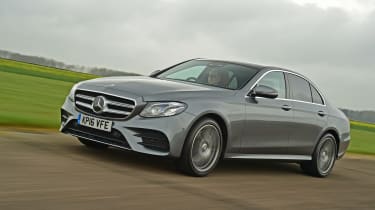
Model: Mercedes E 220 d AMG LinePrice: £40,560Engine: 2.0-litre 4cyl, 191bhp
These two rivals highlight how the German brands have had the executive saloon sector sewn up for so long. The E 220 d boasts comparable power, masses of boot space, plenty of tech and a lovely cabin. AMG Line spec gets lots of kit, too.
Audi A6
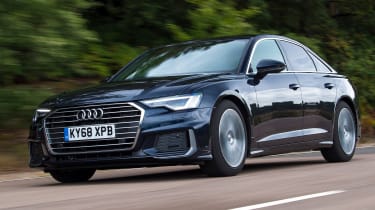
Model: Audi A6 40 TDI S linePrice: £42,000Engine: 2.0-litre 4cyl, 201bhp
The Audi A6 allies even more boot space, at 565 litres, with a classy but reserved interior, a solid powertrain and a smooth ride. It’s not as rewarding to drive as a 5 Series, but is still very good and betters the BMW in other areas with great tech.
Figures
| BMW 520d M Sport | Volvo S90 D4 R-Design | Lexus ES 300h F Sport | |
| On the road price/total as tested | £41,585/£44,770 | £39,260/£45,210 | £38,150/£39,420 |
| Residual value (after 3 years/36,000) | £19,379/46.6% | £18,876/48.1% | £17,499/45.9% |
| Depreciation | £22,206 | £20,384 | £20,651 |
| Annual tax liability std/higher rate | £2,314/£4,628 | £2,262/£4,524 | £1,670/£3,341 |
| Annual fuel cost (12k/20k miles) | £1,642/£2,736 | £1,561/£2,602 | £1,449/£2,414 |
| Insurance group/quote/VED | 31/£526/£450 | 30/£564/£140 | 34/£571/£130 |
| Cost of 1st/2nd/3rd service | £399 (3 years) | £325/£515/£325 | £265/£495/£265 (est.) |
| Length/wheelbase | 4,936/2,975mm | 4,963/2,941mm | 4,355/2,600 mm |
| Height/width | 1,479/1,868mm | 1,443/1,895mm | 1,455/1,765mm |
| Engine | 4cyl in-line/1,995cc | 4cyl in-line/1,969cc | 4cyl/2,487cc/e-motor |
| Peak power/revs | 187/4,000 bhp/rpm | 187/4,250 bhp/rpm | 215/5,700 bhp/rpm |
| Peak torque/revs | 400/1,750 Nm/rpm | 400/1,750 Nm/rpm | 221/3,600 Nm/rpm^ |
| Transmission | 8-speed auto/rwd | 8-speed auto/fwd | CVT automatic/fwd |
| Fuel tank capacity/spare wheel | 66 litres/repair kit | 55 litres/repair kit | 50 litres/repair kit |
| Boot capacity | 530 litres | 500 litres | 454 litres |
| Kerbweight/payload/towing weight | 1,530/685/2,000kg | 1,697/573/1,800kg | 1,680/470kg/N/A |
| Turning circle | 12.1 metres | 11.8 metres | 12.6 metres |
| Basic warranty (miles)/recovery | 3yrs (60,000)/3yrs | 3yrs (60,000)/3yrs | 3yrs (60,000)/3yrs |
| Driver Power manufacturer/dealer pos. | 21st/19th | 13th/9th | 1st/1st |
| NCAP: Adult/child/ped./assist/stars | 91/85/81/59/5 | 95/80/76/93/5 | 91/87/90/77/5 |
| 0-60/30-70mph | 6.9/6.7 secs | 7.7/7.2 secs | 8.2/7.3 secs |
| 30-50mph in 3rd/4th | 2.7/3.1 secs | 3.0/3.9 secs | 2.9 secs** |
| 50-70mph in 5th/6th/7th/8th | 4.4/5.5/6.8/11.4 secs | 4.9/5.8/7.5/10.3 secs | 4.3 secs** |
| Top speed/rpm at 70mph | 146mph/1,600rpm | 140mph/1,750rpm | 112mph/N/A |
| Braking 70-0/60-0/30-0mph | 46.9/34.3/8.9 metres | 45.2/30.4/8.9 metres | 49.9/36.2/8.9 metres |
| Noise outside/idle/30/70mph | 68/52/63/69dB | 76/44/62/72dB | N/A/N/A/63/73dB |
| Auto Express econ. (mpg/mpl)/range | 42.8/9.4/621 miles | 45.0/9.9/544 miles | 45.0/9.9/495 miles |
| WLTP fuel consumption (med) | 48.7mpg/10.7mpl | 48.7mpg/10.7mpl | 48.7mpg/10.7mpl |
| Actual/claimed CO2/tax bracket | 177/119g/km/28% | 168/121g/km/29% | 145/106g/km/22% |
| Airbags/Isofix/park sensors/camera | Six/yes/yes/£375 | Seven/yes/yes/£400 | 10/yes/yes/yes |
| Auto box/lane-keep/blind spot/AEB | Y/£895*/£895*/y | Yes/yes/£500*/yes | Yes/yes/no/yes |
| Climate/cruise ctrl/leather/heated seats | Yes/yes/yes/yes | Yes/adaptive/yes/yes | Yes/yes/yes/yes |
| Met paint/LEDs/keyless/pwr tailgate | £685/yes/£695/£430 | £700/yes/£575/yes | £920/yes/£4,000* |
| Nav/digi dash/DAB/connected services | Yes/yes/yes/yes | Yes/yes/yes/yes | Yes/no/yes/yes |
| Wireless charge/CarPlay/Android Auto | £475/£235/no | No/£300*/£300* | £700*/no/no |
